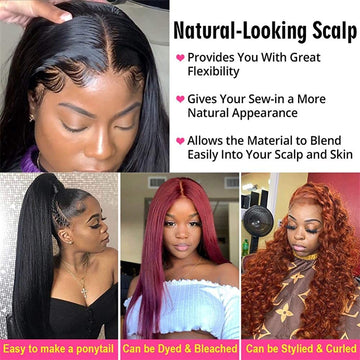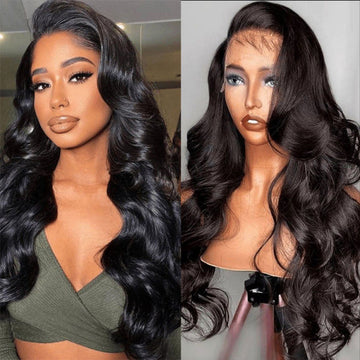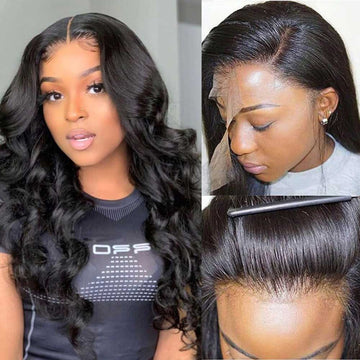How To Fix An Over-Plucked Wig
on
Unless you’re piecing together a Halloween costume, the goal is always for your wig to look sleek and seamless. Like, so seamless, no one even questions whether or not it’s real. But there’s a difference between wanting a flawless fit
and actually achieving one. Customizing your wig is the one thing that can help close that gap. That means you need to pluck your wig so it’s specifically tailored to your hairline—it's the best way to make it look as natural as
possible.
Why do you pluck a wig?
When it comes to lace-front wigs, it’s all about the hairline. Plucking a wig is the process of using a tweezer to get rid of the excess hair around the hairline of a lace-front wig, says Johnson. Think of a wig that hasn’t been
plucked—the hairline is typically super straight, which basically screams, “Not my real hair!” If you look at your natural hairline, you’ll see that the hairs aren’t all the same length. That’s because new hairs are growing in all
the time. So unless you want your wig to have the helmet head effect, go ahead and grab those tweezers to get rid of the extra bulk.
Here’s what you’ll need in your tool-kit: a lace-front wig (duh), a wig stand, pins, a rattail comb, and tweezers. You can pluck on wet or dry hair. Some people prefer wet hair because it's easier to move and control, while other
people prefer to pluck on dry hair so they can get a true sense of the hair's density. It's really up to you.
Step 1. Put your hair on the wig stand
You’re going to want to secure it with pins. This will make sure that your wig doesn’t slide all over when you’re going at your hairline with tweezers.
Step 2. Run a comb through the front of your hair
Using a rattail comb, smooth back your hairline to make sure there aren’t any knots or tangles. Then with your less-dominant hand, pull the hair back away from the hairline.
Step 3. Slowly start to pluck the wig
With your dominant hand, grab the tweezers and being plucking hair strands straight back, away from the face. According to hairstylist, you’ll be going in with quick strokes. She recommends plucking about every other hair
strand to make sure that everything is spaced out (this also helps you avoid bald spots). Start at your hairline, right above your ear, and work your way to the middle.
She also recommends taking your time—if you over-pluck, there’s no going back. You also want to make sure that you’re plucking the hair, not the lace. If you go in on the lace with tweezers, you can end up ripping it (not great).
Step 4. Repeat the step above with additional layers of hair
Remember, when you pluck your hair, you’re not just plucking the front of your hairline near your forehead. The goal is to make the entire front of the wig look less dense, so you need to pluck several layers of hair.
So, once you’re done with step three, comb out the excess hair you’ve plucked. Then, going from ear to ear, part a thin section of hair and flip it forward (over the head of the wig stand). Pluck that layer to help get rid of the bulkiness. When you’re done with this layer, repeat this step about three to four more times, depending on how deep you want your wig to be plucked.
Brush out everything you’ve plucked out, and boom—you’ve got a natural-looking hairline.
and actually achieving one. Customizing your wig is the one thing that can help close that gap. That means you need to pluck your wig so it’s specifically tailored to your hairline—it's the best way to make it look as natural as
possible.
Why do you pluck a wig?
When it comes to lace-front wigs, it’s all about the hairline. Plucking a wig is the process of using a tweezer to get rid of the excess hair around the hairline of a lace-front wig, says Johnson. Think of a wig that hasn’t been
plucked—the hairline is typically super straight, which basically screams, “Not my real hair!” If you look at your natural hairline, you’ll see that the hairs aren’t all the same length. That’s because new hairs are growing in all
the time. So unless you want your wig to have the helmet head effect, go ahead and grab those tweezers to get rid of the extra bulk.
Here’s what you’ll need in your tool-kit: a lace-front wig (duh), a wig stand, pins, a rattail comb, and tweezers. You can pluck on wet or dry hair. Some people prefer wet hair because it's easier to move and control, while other
people prefer to pluck on dry hair so they can get a true sense of the hair's density. It's really up to you.
Step 1. Put your hair on the wig stand
You’re going to want to secure it with pins. This will make sure that your wig doesn’t slide all over when you’re going at your hairline with tweezers.
Step 2. Run a comb through the front of your hair
Using a rattail comb, smooth back your hairline to make sure there aren’t any knots or tangles. Then with your less-dominant hand, pull the hair back away from the hairline.
Step 3. Slowly start to pluck the wig
With your dominant hand, grab the tweezers and being plucking hair strands straight back, away from the face. According to hairstylist, you’ll be going in with quick strokes. She recommends plucking about every other hair
strand to make sure that everything is spaced out (this also helps you avoid bald spots). Start at your hairline, right above your ear, and work your way to the middle.
She also recommends taking your time—if you over-pluck, there’s no going back. You also want to make sure that you’re plucking the hair, not the lace. If you go in on the lace with tweezers, you can end up ripping it (not great).
Step 4. Repeat the step above with additional layers of hair
Remember, when you pluck your hair, you’re not just plucking the front of your hairline near your forehead. The goal is to make the entire front of the wig look less dense, so you need to pluck several layers of hair.
So, once you’re done with step three, comb out the excess hair you’ve plucked. Then, going from ear to ear, part a thin section of hair and flip it forward (over the head of the wig stand). Pluck that layer to help get rid of the bulkiness. When you’re done with this layer, repeat this step about three to four more times, depending on how deep you want your wig to be plucked.
Brush out everything you’ve plucked out, and boom—you’ve got a natural-looking hairline.










